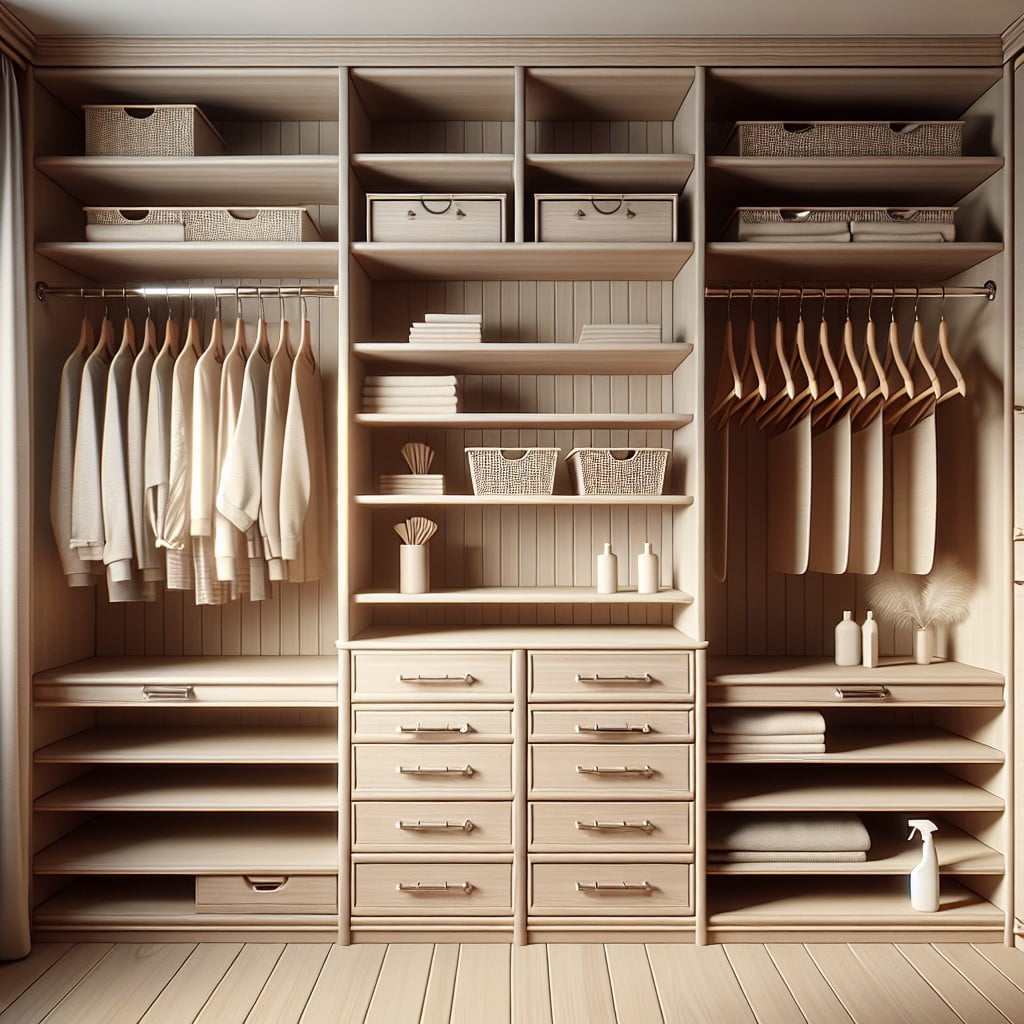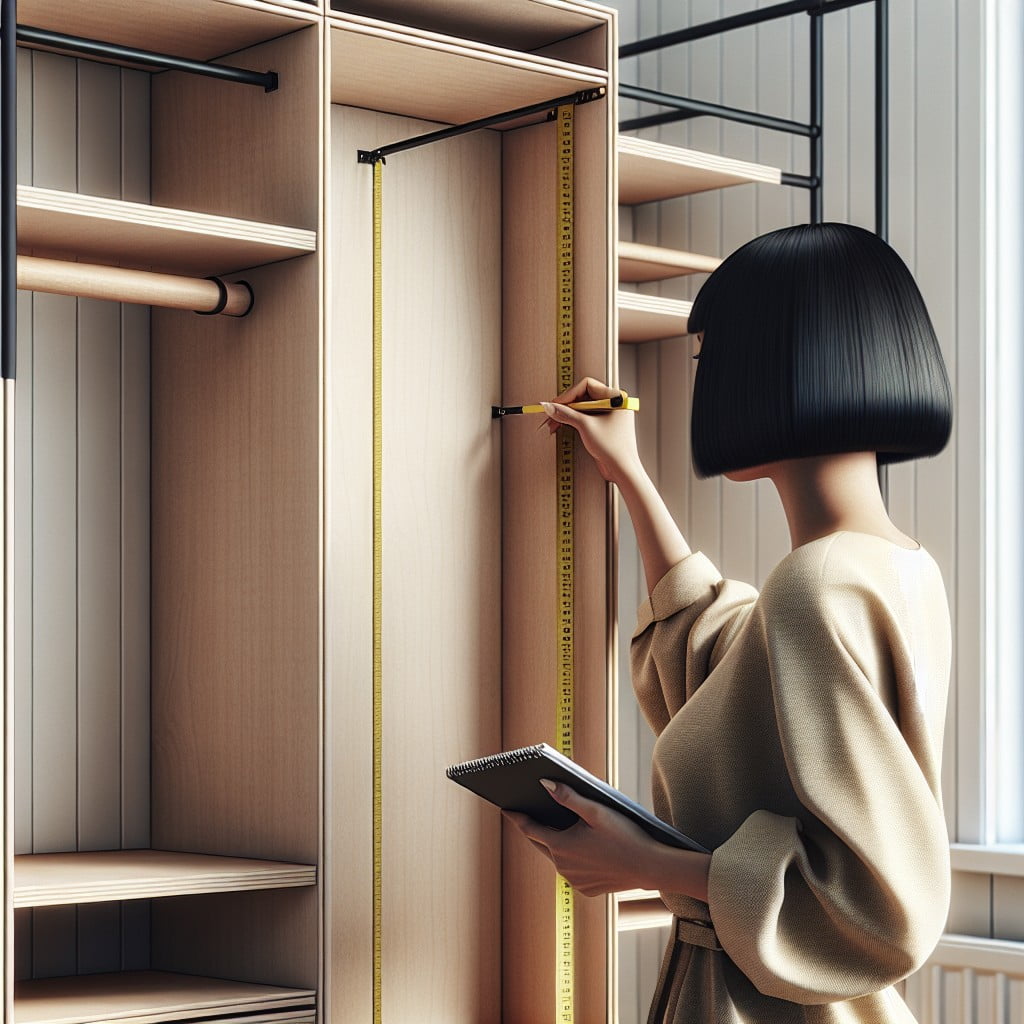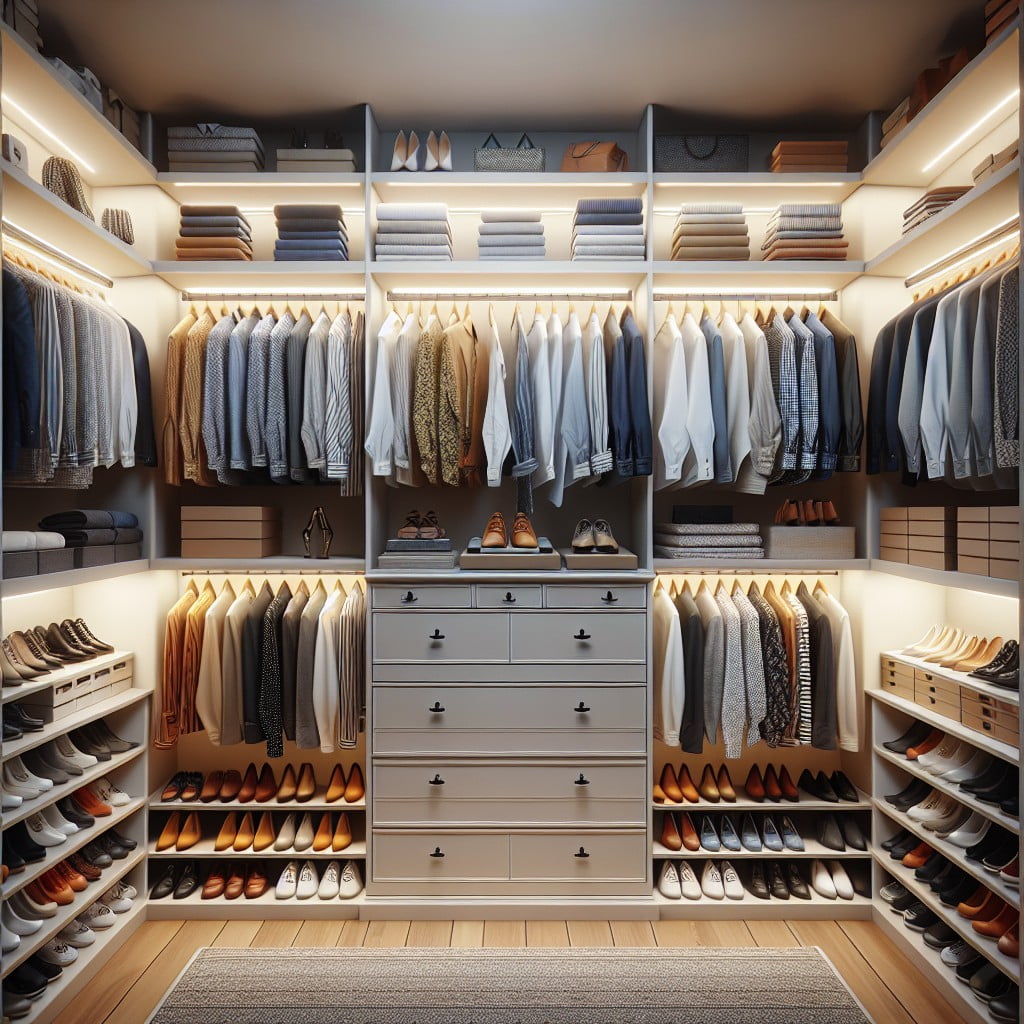Last updated on
Revamping your closet can transform your daily routine because it streamlines the task of picking out your outfits, making it a faster and more enjoyable process.
Key takeaways:
- Assess and clear out current closet contents
- Clean the closet thoroughly
- Measure the closet’s dimensions accurately
- Design a well-thought-out closet layout
- Select the right storage solutions for your needs
Assess and Clear Out Current Closet Contents

Start by removing everything from your closet to assess what you have. This step gives you a blank canvas and helps identify items to keep, donate, or discard.
Sort belongings into clear categories: clothing, accessories, shoes, and so forth.
Be ruthless in decluttering — if it hasn’t been used in a year or doesn’t fit, it’s probably time to say goodbye.
Use this opportunity to clean items you plan to keep before they go back into the closet.
Once the closet is empty, you’ll have a clearer picture of the storage space available and can make decisions about optimizing it efficiently.
Keep an inventory of items you’re keeping to aid in designing your new closet layout.
Clean the Closet

Once you’ve emptied your closet, seize the moment to tackle any accumulated dust and debris. Here’s how:
1. Start with Dusting: Begin from the top and work your way down. Use a duster or a microfiber cloth to wipe down shelves, rods, and hooks. Don’t overlook the corners and high shelves, where cobwebs often hide.
2. Wipe Surfaces: Dampen a cloth with a mixture of mild soap and water, and wipe down all surfaces to remove any lingering dust or grime.
3. Vacuum or Sweep: Ensure thorough removal of dust and smaller particles from the closet floor by sweeping or using a vacuum with a hose attachment to get into tight spots and edges.
4. Mop or Clean Flooring: If your closet has a hard surface, follow up with a mop. Use appropriate cleaners for whatever flooring type you have to avoid damage.
5. Address Stains and Odors: For any stubborn stains or odors, utilize specialty cleaning products designed for the specific surface you’re treating.
6. Let It Air Out: Before reassembling, allow the closet to air out completely to prevent mold or mildew from developing in a damp environment.
By ensuring your closet space is spotless, you provide a clean slate for your new organization system and extend the life of your belongings stored within.
Measure Closet’s Dimensions

Taking accurate measurements is crucial because it ensures that your new storage solutions will fit perfectly within the available space. Use a tape measure to determine the width, depth, and height of your closet area. Jot down any irregularities, such as notches, or if the closet isn’t a perfect rectangle. Don’t forget to consider the door swing or any existing built-ins that you plan to keep. If you’re considering adding large accessories like a built-in dresser or any additional features that require wall space, this is the time to account for those dimensions as well.
Remember to measure the closet rod’s height if you’re planning on hanging items: short-hang for shirts and tops is typically around 42 inches high, while long-hang for dresses and coats should be approximately 70 inches. For shelving, allow at least 12 inches in depth for folded clothes, keeping in mind that larger items like comforters or suitcases may need more space. These precise measurements will be your guide when selecting components for your closet remodel.
Design Your Ideal Closet Layout

Consider your wardrobe when plotting the layout—allocate space for dresses, suits, and longer items accordingly.
Incorporate a mix of hanging rods at various heights to maximize vertical storage and to categorize clothing by type or season.
Include drawers or shelves for folded items, and don’t forget smaller compartments for lingerie and accessories.
Handy tip: Drawers beneath hanging clothes can utilize lower space that often goes wasted.
Evaluate corner solutions; these can be tricky spots but offer potential for additional storage with creative designs such as carousel units.
Always leave enough clearance for doors or drawers to open fully—you’ll want to access all items with ease.
Lastly, ensure each section’s purpose aligns with your daily routine for a seamless getting-ready process.
Select Closet Storage Solutions
To ensure your closet caters to your storage needs, prioritize a mix of hanging space, drawers, and shelves. Adjustable shelving offers flexibility for varying item heights, while drawers are perfect for smaller garments and accessories.
Incorporate a variety of rod heights to accommodate both longer items such as dresses and shorter ones like shirts. Adding specialized organizers for shoes, ties, or jewelry can maximize space and maintain order.
When choosing materials, consider durability and ease of cleaning; wire and laminate options are both popular for their practicality. For those with limited space, over-the-door storage or wall-mounted hooks can be a smart way to utilize every inch.
Remember, the right combination of these elements can transform the way you interact with your wardrobe daily, creating a functional and streamlined space.
Choose Shelving and Hanging Organizers
When selecting shelves, consider both depth and adjustability. Shallow shelves are excellent for smaller items to prevent them from getting lost behind each other. For bulkier items, deeper shelves offer more storage flexibility. Adjustable shelving systems allow reconfiguration based on changing wardrobe needs.
For hanging organizers, differentiate between long-hang and double-hang sections. Long-hang areas are essential for dresses and overcoats, while double-hang sections maximize space efficiency for shirts, blouses, and pants.
Wall-mounted uprights with brackets provide a versatile option, permitting shelf and rod height adjustments without tools. Investing in quality materials like solid wood or wire ensures durability and an improved appearance.
Lastly, for oddly shaped items or accessories, specialty organizers such as hooks, racks, or specific hangers can prevent clutter and keep items easily accessible.
Optimize Lighting Fixtures
Enhancing visibility in your closet not only makes it easy to find what you’re looking for but also elevates the space’s ambiance. Consider replacing dull or outdated fixtures with bright LED lights, known for their energy efficiency and longevity.
If your closet lacks natural light, installing a high-lumen output option can illuminate every nook and cranny.
For a more sophisticated touch, add motion sensor lights that brighten up the space automatically upon entry, providing convenience and a touch of luxury.
Under-shelf lighting can highlight individual shelves, making it easier to differentiate between items.
If you have a walk-in closet, a statement light fixture, like a small chandelier or pendant light, can serve as both a light source and a decorative centerpiece, enhancing the overall aesthetics of your closet.
Remember, the goal is to create a well-lit space where everything is clearly visible and accessible, transforming the act of choosing an outfit into a pleasant experience.
Choose Durable and Attractive Flooring
Selecting the right flooring for your closet is both a practical and aesthetic decision. Hardwood floors are a popular option, offering longevity and a classic look that can increase your home’s value.
If budget is a concern, laminate can mimic the appearance of wood at a fraction of the cost and is quite resistant to scratches and scuffs.
For a touch of luxury, consider plush carpeting that brings warmth and comfort underfoot, an inviting feature when dressing.
Vinyl flooring is another resilient choice that comes in a variety of patterns and can withstand heavy traffic.
Whichever material you choose, ensure it complements the overall design theme of your closet and aligns with your maintenance preferences.
Consider Door Upgrades
Swapping out your old closet door for a new one can have a significant impact on both the look and functionality of your space. Pocket doors are great space-savers as they slide into the wall, requiring no clearance to open. Alternatively, bi-fold or sliding doors offer ease of access without taking up extra room when they’re open. For those looking to make a statement, consider barn doors that glide on an exterior track system – stylish and practical.
If full replacement isn’t in the cards, updating door handles or applying a fresh coat of paint can refresh the appearance of your current doors. Don’t forget to ensure the doors properly align with your chosen closet systems to maximize accessibility and aesthetics.
Pick Accessory Storage Options
When it comes to keeping your accessories tidy and easily accessible, here are some clever solutions to consider:
- Jewelry Organizers: Wall-mounted hooks or a hanging jewelry organizer can ensure necklaces and bracelets remain untangled and earrings are paired neatly. For a more sophisticated touch, invest in a velvet-lined jewelry drawer.
- Scarf Hangers: Use multi-loop organizers to drape scarves, keeping them wrinkle-free and visible for a quick selection when outfitting.
- Belt Racks: Save space by installing a sliding belt rack inside your closet or using a belt hanger on the closet rod.
- Shoe Storage: Consider a shoe rack on the closet floor, an over-the-door organizer, or clear shoe boxes stacked on shelves to protect and display your collection.
- Hat Boxes: Stackable, clear boxes or dedicated hat racks can help maintain the shape of hats while making them easy to find.
- Drawer Dividers: Use these for smaller items like ties, socks, and undergarments to keep them sorted and in-place.
Selecting the right mix of these options will help keep your accessories organized and safeguard their condition.
Decide On Closet System: DIY, Pre-Fab, or Custom
Choosing the right closet system is crucial to maximize space and efficiency. If you’re handy with tools and enjoy a weekend project, a DIY setup can be cost-effective and highly customized to your space. Many home improvement stores offer modular components like wire shelving and drawers that you can mix and match.
For those seeking a quicker turnaround or who may not be as comfortable with power tools, pre-fabricated units are a convenient option. They come in various styles and sizes, ready to be assembled and installed, often requiring minimal effort with a simple set of instructions.
Meanwhile, a custom-built closet can be the ultimate solution for those wishing to utilize every inch of space perfectly. Though more expensive, it allows for a personalized approach, with professionals taking measurements and designing a system that fits both your space and your wardrobe to a tee. Whether it’s extra shoe storage or space for long dresses, a custom design ensures your needs are met precisely. Consider this option if you’re looking for a long-term investment in your home.
Personalize With Color and Decor
Adding a personal touch to your closet can transform it from a mere storage space to a delightful part of your daily routine. Consider these elements to enhance its appearance:
- Paint: Select a color that complements your bedroom or inspires positivity. Light hues can make the space feel larger, while bold colors can add energy.
- Wallpaper: A patterned wallpaper can act as a statement piece, especially on the back wall of your closet.
- Lighting: Install cool-white LEDs to improve visibility or add a small chandelier for a touch of elegance.
- Hardware: Swap out generic knobs and handles with unique or luxurious hardware to elevate the overall look.
- Seating: If space allows, include a bench or ottoman for comfort when trying on shoes.
- Rugs: A plush rug adds warmth underfoot and can tie the room’s decor together.
- Artwork: Hang art or photos that inspire you; this can be an especially uplifting touch if you often start your day choosing an outfit.
By focusing on these details, you create a space that is not just functional but also a joy to use.
Organize Clothes, Shoes, and Accessories in the New Closet
Starting with a categorization system simplifies the process; group items by type, such as all shirts together, pants in another section, and so forth. Within each category, you may want to arrange items by color or season, which not only makes finding what you need easier but also lends a pleasing aesthetic to your closet.
Next, prioritize placement based on usage. Hang or shelve clothes you wear most often at eye level for easy access, while out-of-season or special occasion outfits can be stored higher up or in less accessible areas.
For shoes, clear storage boxes or a shoe rack can help keep pairs together and in good condition. If space allows, a designated shoe cabinet within your closet can be both functional and upscale.
Accessories require thoughtful storage solutions – hooks or velvet-lined drawers for jewelry, clear bins or dividers for scarves and belts, and sturdy hangers for ties and bags ensure each item has a proper place, preventing tangles and damage.
Finally, maintain this organization by regularly revisiting and adjusting your system to fit your changing wardrobe and lifestyle needs.
Maintain Closet Organization
To ensure your revamped closet stays orderly and accessible:
- Establish a routine: Spend a few minutes daily rehanging clothes and placing items back in their designated spots.
- Seasonal review: Change out clothes with the seasons and donate items you no longer wear.
- The one-in-one-out rule: When you acquire a new item, choose an older one to discard, keeping your closet from becoming overcrowded.
- Visibility is key: Keep items you use frequently at eye level and within reach to maintain structure effortlessly.
- Implement storage discipline: Use designated bins for specific items and resist the urge to toss things in randomly.
- Fold clothes consistently: Use the same folding technique for each type of garment to maximize space and reduce clutter.
- Regular declutter sessions: Schedule monthly or quarterly reviews of your closet’s contents to remove any items that are no longer needed or loved.
By integrating these habits, your closet will remain a model of organization and efficiency.
FAQ
Can I redo my own closet?
Yes, it is possible to redo your own closet either by taking on the project individually or by collaborating with a DIY enthusiast or a custom closet designer.
How much does it cost to revamp a closet?
The cost for a closet remodel typically averages around $358, though it can range from $644 to $1,275 on the higher end, based on a national average cost of approximately $125 per linear foot.
What essential tools are needed for a closet makeover?
Essential tools for a closet makeover include a tape measure, graph paper, a pencil, a screwdriver, a drill, saw, level, stud finder, and diverse storage solutions like shelves, rods, boxes, and baskets.
How can space utilization be maximized during a closet revamp?
Maximizing space utilization during a closet revamp can be achieved by incorporating multi-functional furniture, vertical storage solutions, and appropriate shelving, alongside regular decluttering.
Are there any common mistakes to avoid during a DIY closet renovation?
Common mistakes to avoid during a DIY closet renovation include overlooking proper measurements, ignoring the importance of appropriate lighting, neglecting proper ventilation, choosing wrong materials, and failing to plan for future wardrobe expansions.
Recap:




